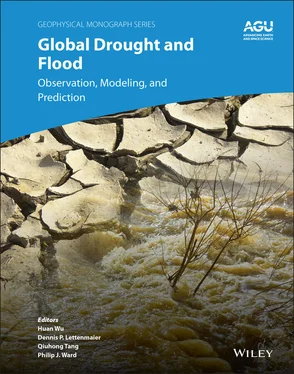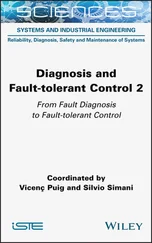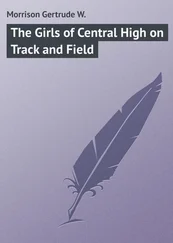40 Kogan, F., Adamenko, T., & Guo, W. (2013). Global and regional drought dynamics in the climate warming era. Remote Sensing Letters, 4, 364–372.
41 Kustas, W.P. (1990). Estimates of evapotranspiration with a one‐ and two‐layer model of heat transfer over partial canopy cover. Journal of Applied Meteorology, 29, 704–715.
42 Kustas, W.P., & Norman, J.M. (1996). Use of remote sensing for evapotranspiration monitoring over land surfaces. Hydrological Sciences Journal, 41, 495–516.
43 Kustas, W.P., & Norman, J.M. (1997). A two‐source approach for estimating turbulent fluxes using multiple angle thermal infrared observations. Water Resources Research, 33, 1495–1508.
44 Lagouarde, J.‐P. (1991). Use of NOAA AVHRR data combined with an agrometeorological model for evaporation mapping. International Journal of Remote Sensing, 12, 1853–1864.
45 Loague, K.M. & Freeze, R.A. (1985). A Comparison of Rainfall‐Runoff Modeling Techniques on Small Upland Catchments. Water Resources Research, 21, 229–248.
46 McFarland, M.J., R. L. Miller & C. M. U. Neale (1990). Land surface temperature derived from the SSM/I passive microwave brightness temperatures. IEEE Transactions on Geoscience and Remote Sensing, 28, 839–845.
47 McNaughton, K.J. & T. W. Spriggs (1986). A mixed‐layer model for regional evaporation Boundary‐Layer Meteorology, 74, 243–262.
48 Mecikalski, J.M., Diak, G.R. M.C. Anderson & J.M., Norman (1999). Estimating fluxes on continental scales using remotely sensed data in an atmosphere‐land exchange model. Journal of Applied Meteorology, 38, 1352–1369.
49 Miralles, D.G., Crow, W.T. & Cosh, M.H. (2010). Estimating Spatial Sampling Errors in Coarse‐Scale Soil Moisture Estimates Derived from Point‐Scale Observations. Journal of Hydrometeorology, 11, 1423–1429.
50 Monteith, J.L. (1964). Evaporation and environment. The state of movement of water in living organisms. In Symposium of the society of experimental biology, 205−234.
51 Monteith, J.L. (1988). Does transpiration limit the growth of vegetation or vice versa? Journal of Hydrology, 100, 57–68.
52 Moran, M.S., Clarke, T.R., Inoue, Y., & Vidal, A. (1994). Estimating crop water deficit using the relation between surface‐air temperature and spectral vegetation index, Remote Sensing of the Environment, 49, 246–263.
53 Mu, Q., Heinsch, F.A., Zhao, M., & Running, S.W. (2007). Development of a global evapotranspiration algorithm based on MODIS and global meteorology data. Remote Sensing of Environment, 111, 519536.
54 Neale, C.M.U., Jayanthi, H., & Wright, J.L. (2005). Irrigation water management using high resolution airborne remote sensing. Irrigation and Drainage Systems, 19, 321–336.
55 Norman, J.M., & Becker, F. (1995). Terminology in thermal infrared remote sensing of natural surfaces. Agricultural and Forest Meteorology, 77, 153–166.
56 Norman, J.M., Kustas, W.P., & Humes, K.S. (1995). A two‐source approach for estimating soil and vegetation energy fluxes from observations of directional radiometric surface temperatures. Agricultural and Forest Meteorology, 77, 263–293.
57 Otkin, J.A., Anderson, M.C., Hain, C.R., & Svoboda, M. (2014). Using temporal changes in drought indices to generate probabilistic drought intensification forecasts. Journal of Hydrometeorology, 16(1), 110–125.
58 Penman, H.L. (1948). Natural evaporation from open water, bare soil and grass. Proceedings of the Royal Society of London, Series A, Mathematical and Physical Sciences, 193, 120–145.
59 Price, J.C. (1980). The potential of remotely sensed thermal infrared data to infer surface soil moisture and evaporation. Water Resources Research, 16, 787–795.
60 Price, J.C. (1982). Estimation of regional scale evapotranspiration through analysis of satellite thermal‐infrared data. IEEE Transactions on Geoscience and Remote Sensing, GE‐20, 286–292.
61 Priestley, C.H.B., & Taylor, R.J. (1972). On the assessment of surface heat flux and evaporation using large‐scale parameters. Monthly Weather Review, 100(2), 81–92. doi:10.1175/1520‐0493(1972)100<0081:OTAOSH>2.3.CO;2
62 Rabin, R.M., Stadler, S. Wetzel, P.J., Stensrud, D.J., & Gregory, M. (1990). Observed effects of landscape variability on convective clouds. Bulletin of the American Meteorological Society, 71, 272–280.
63 Scipal, K., Holmes, T., de Jeu, R., Naeimi, V., & Wagner, W. (2008). A possible solution for the problem of estimating the error structure of global soil moisture data sets, Geophysical Research Letters, 35, L24403. doi:10.1029/2008GL035599
64 Sellers, P.J., Rasool, S.I., & Bolle, H.‐J. (1990), A review of satellite data algorithms for studies of the land surface. Bulletin of the American Meteorological Society, 71, 1429–1447.
65 Shuttleworth, W.J., Gurney, R.J., Hsu, A.Y., & Ormsby, J.P. (1989). FIFE, the variation on energy partition at surface flux sites. Washington, DC: Proceedings of IAHS Third International Assembly, International Association of Hyrological Scientists.
66 Stoffelen, A. (1998). Toward the true near‐surface wind speed: Error modeling and calibration using triple collocation. Journal of Geophysical Research: Oceans, 103, 7755–7766.
67 Su, H., McCabe, M.F., Wood, E.F., Su, Z., & Prueger, J.H. (2005). Modeling evapotranspiration during SMACEX: Comparing two approaches for local‐ and regional‐scale prediction. Journal of Hydrometeorology, 6, 910–922.
68 Sugita, M. & Brutsaert, W. (1991). Daily evaporation over a region from lower boundary layer profiles measured with radiosondes. Water Resources Research, 27, 747–752.
69 Tadesse, T., Wardlow, B.D., Brown, J.F., Svoboda, M.D., Hayes, M.J., Fuchs, B., & Gutzmer, D. (2015). Assessing the vegetation condition impacts of the 2011 drought across the U.S. Southern Great Plains using the Vegetation Drought Response Index (VegDRI). Journal of Applied Meteorology and Climatology, 54, 153–169.
70 Tang, Q., Peterson, S., Cuenca, R.H., Hagimoto, Y., & Lettenmaier,D.P. (2009). Satellite‐based near‐real‐time estimation of irrigated crop water consumption, Journal of Geophysical Research, 114, D05114. doi:10.1029/2008JD010854
71 Tanner, C.B. & Jury, W.A. (1976). Estimating evaporation and transpiration from a row crop during incomplete cover. Agronomy Journal, 68, 239243.
72 Tennekes, H. (1973). A model for the dynamics of the inversion above a convective boundary layer. Journal of Atmospheric Science, 30, 558–567.
73 Thornthwaite, C.W. (1948). An approach toward a rational classification of climate. Geographical Review, 38, 55–94.
74 Vinukollu, R.K., Wood, E.F., Ferguson, C.R., & Fisher, J.B. (2011). Global estimates of evapotranspiration for climate studies using multi‐sensor remote sensing data: Evaluation of three process‐based approaches. Remote Sensing of Environment, 115, 801–823.
75 Wang, K. & Dickinson, R.E. (2012). A review of global terrestrial evapotranspiration: Observation, modeling, climatology, and climatic variability. Reviews of Geophysics, 50. https://doi.org/10.1029/2011RG000373
76 Wetzel, P.J., Atlas, D., & Woodward, R.H. (1984). Determining soil moisture from geosynchronous satellite infrared data: A feasibility study. Journal of Climate and Applied Meteorology, 23, 375–391. https://doi.org/10.1175/1520‐0450(1984)023<0375:DSMFGS>2.0.CO;2
77 Yin, J., Zhan, X., Hain, C.R., Liu, J., & Anderson, M.C. (2018). A method for objectively integrating soil moisture satellite observations and model simulations toward a blended drought index. Water Resources Research, 54. https://doi.org/10.1029/2017WR021959
78 Zhan, X., Kustas, W.P., & Humes, K.S. (1996). An intercomparison study on models of sensible heat flux over partial canopy surfaces with remotely sensed surface temperature. Remote Sensing of Environment, 58, 242–256.
Читать дальше












